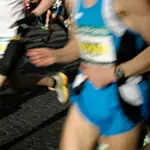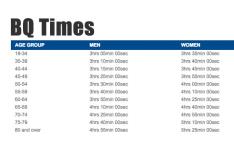That's just a subtle difference between the two paces, making this essentially a fartlek workout. But as with all well-run fartlek workouts, the "off" portion is still solid running—in this case, marathon pace. If you continue running and finish with a cooldown of 1 mile, you get a total continuous run of 15 miles.
More: Another Marathon-Specific Fartlek Workout
The Benefits of Running Two Paces in One Workout
Now, you might be ask, "Why should I do this workout that alternates between paces rather than run just one pace?"
The first reason is this workout is easy to recover from, as 4 miles are done at half-marathon pace and 4 miles are done at marathon pace. As you move closer to your peak marathon fitness, this is not a killer workout.
The second reason is you have to change pace continually, and doing so is as much a mental task as a physical one. During the marathon, you'll hit a rough patch where you'll feel horrible and, at that point, you'll likely slow down. Most athletes will soon feel a bit better and want to get back on pace. A workout like this helps you practice the skill of dealing with a subtle change in pace as you start to fatigue.
More: Train Your Brain to Deal With Fatigue
Workout 2: Run at Marathon Pace Close to Race Day
When it comes to running marathon pace, there are numerous workouts that are sound, but one that I like near the end of training is very simple: 10 miles at marathon pace. You get to decide the warm-up and the cooldown, but try to run 15 miles total.
Take 3 miles to warm up, then go right into your marathon pace—as close to the minute-per-mile pace that you're hoping to run in the race as possible—with a singular focus: staying relaxed. If you can learn to stay relaxed, with efficient biomechanics and calm respiration, you'll increase your chance of running to your fitness level in the marathon. Cool down for 2 miles, and that gets you to 15 miles.
More: Marathon Pacing: How to Run Your Best Race
There's nothing magic about 15 miles, though, so if you only cool down for 1 mile, you should feel good about your 14-mile run with 10 miles at marathon pace. The key is the running done at marathon pace.The one problem with this workout is you can overthink it and ruminate on thoughts such as, "How am I going to run this for 26.2 miles?" or, "This is way too fast for me—I can't do this for the entire race distance!" You can't have those thoughts during this workout and run it well.
More: Want to Run Faster? Learn to Relax
If you've done all of the other necessary marathon work, this workout will be a nice way to get a stimulus before the big day that you can recover from within a few days.
Both of these workouts are great for people who are running their entire marathon. If you're on a run/walk program, these workouts don't make sense, but give you something to work toward during a future marathon training cycle.
More: Marathon Training Tips for First-Timers
 Sign up for your next marathon race.
Sign up for your next marathon race. - 2
- of
- 2
About the Author

Get ACTIVE on the Go


13.one Half Marathon
Get expert advice and guidance as you progress in your journey to becoming an avid runner.
Available for iOS







Discuss This Article